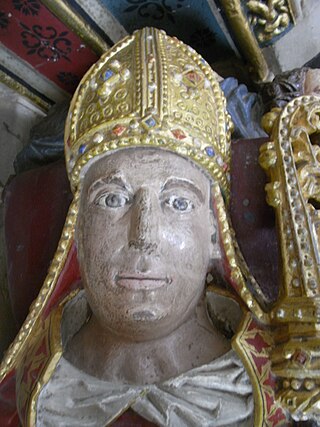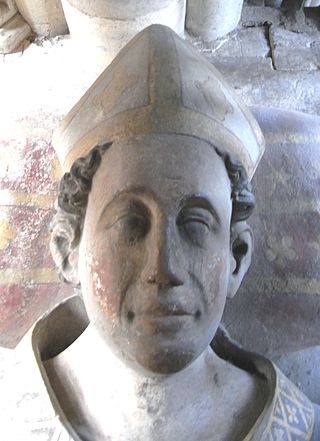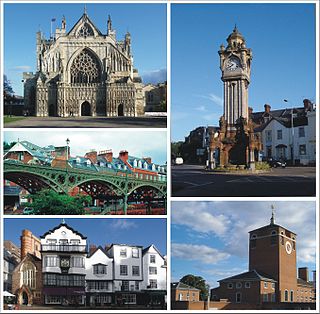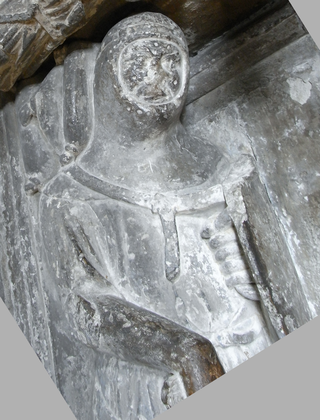Related Research Articles

Exeter Cathedral, properly known as the Cathedral Church of Saint Peter in Exeter, is an Anglican cathedral, and the seat of the Bishop of Exeter, in the city of Exeter, Devon, in South West England. The present building was complete by about 1400 and has several notable features, including an early set of misericords, an astronomical clock and the longest uninterrupted medieval stone vaulted ceiling in the world.

Hugh Oldham was an English cleric who was Bishop of Exeter (1505–19) and a notable patron of education as a founder and patron of Manchester Grammar School and Corpus Christi College, Oxford.

Walter de Stapledon was Bishop of Exeter 1308–1326 and twice Lord High Treasurer of England, in 1320 and 1322. He founded Exeter College, Oxford and contributed liberally to the rebuilding of Exeter Cathedral. His tomb and monument, of great architectural importance, survives in Exeter Cathedral. He was killed by a mob during the London uprising.

The Bishop of Exeter is the ordinary of the Church of England Diocese of Exeter in the Province of Canterbury. Since 30 April 2014 the ordinary has been Robert Atwell.
The Diocese of Ratzeburg is a former diocese of the Catholic Church. It was erected from the Diocese of Oldenburg c. 1050 and was suppressed in 1554. The diocese was originally a suffragan of the Archdiocese of Hamburg; in 1072 it became a suffragan of the merged entity — the "Archdiocese of Hamburg and the Diocese of Bremen". The territory of the diocese was located in what is today the states of Schleswig-Holstein and Mecklenburg-Vorpommern in Germany. The cathedral church of the diocese — dedicated to Ss. Mary and John — is still extant in the city of Ratzeburg. Following its suppression as part of the Protestant Reformation, the remaining Catholic adherents were only represented by the Apostolic Vicariate of Northern Germany. The whole territory of the diocese is today included in the Roman Catholic Archdiocese of Hamburg.

Walter Branscombe was Bishop of Exeter from 1258 to 1280.

Richard Blund was a medieval Bishop of Exeter.

Peter Quinel was a medieval Bishop of Exeter. He became a canon of Exeter Cathedral in 1276 and his episcopate began in 1280 and continued until he died in 1291. He issued a set of rules governing the clergy in his diocese and the required furnishing of churches and continued the rebuilding efforts at Exeter Cathedral.
Events from the 1280s in England.
George Oliver (1781–1861) was an English Roman Catholic priest and a historian of Exeter, Devon, England, and its environs.

Exeter is a cathedral city and the county town of Devon, South West England. It is situated on the River Exe, approximately 36 mi (58 km) northeast of Plymouth and 65 mi (105 km) southwest of Bristol.

The area of Cathedral Close, Exeter has been in the centre of Exeter, Devon, England, since Roman times when there was a basilica and a bath house in this area. A church was established here by the seventh century when a young Saint Boniface came from Crediton to study. The area was walled after 1283 and seven gates into the yard were created. The gates included one at St Petrocks and the original grand entrance into the yard – Broadgate. This created the cathedral close.

Bideford Long Bridge in North Devon spans the River Torridge near its estuary and connects the old part of the town, and formerly important river port, of Bideford on the left bank with East-the-Water on the right bank. It is one of the longest mediaeval bridges in England, being 677 feet long with 24 arches. In 1790 the bridge was the longest in Devon. It remained the furthest downstream bridge on the river until 1987, when the Torridge A39 Road Bridge was built a mile or so further downstream at Northam. The river is still tidal at Bideford and a very large fluctuation in water levels occurs twice daily under the bridge. An ancient New Year's Eve tradition was to try to run across the Long Bridge during the time taken for the bells of St. Mary's parish church, near the west end, to chime midnight. A sight enjoyed by many in the winter months is of the starlings at dusk, as they come in large flocks to roost underneath the bridge.

Sir Richard de Stapledon of Annery in the parish of Monkleigh, North Devon, England, was a judge and the elder brother of Walter de Stapledon (1261-1326), Bishop of Exeter. His effigy and monument survive in Exeter Cathedral.

The Mayor of Exeter, granted Lord Mayor of Exeter in 2002, is the Mayor of Exeter in the ceremonial county of Devon, England and is elected by and from within the councillors of the City of Exeter council. The position is the third oldest mayoralty in the United Kingdom, behind the Lord Mayor of London and Mayor of Winchester, being founded in 1200.
Thomas was a Hungarian prelate in the 13th century, who served as Bishop of Vác from 1278 until his assassination. Simultaneously, he served in the royal court in various positions. He was a faithful confidant of King Ladislaus IV of Hungary.
References
- ↑ Izacke, Richard (1677). Antiquities of the City of Exeter.
- 1 2 Jenkins, Alexander (1806). City of Exeter and its environs, Ancient and modern. P Hedgland, Exeter.
- ↑ Catholic Church: Diocese of Exeter (1889). The registers of Walter Bronescombe (A.D. 1257-1280), and Peter Quivil (A.D. 1280-1291), bishops of Exeter : with some records of the episcopate of Bishop Thomas de Bytton (A.D. 1292-1307); also the taxation of Pope Nicholas IV, A.D. 1291--(diocese of Exeter). G Bell & Sons, London.
- ↑ Woolmer, Shirley (1811). A Concise Account of the City of Exeter: Its Neighbourhood, and Adjacent Watering Places (2nd ed.). pp. 48–50.
- ↑ "Mayor first victim of gallows he had made". Western Morning News. 1938-10-29.
- ↑ Prince, John (1810). Danmonii orientales illustres: or, the worthies of Devon.
- ↑ Hingeston, Francis Charles. Episcopal registers of the diocese of Exeter, 1257-1360. pp. 442–443.
- ↑ Oliver, George (1861). The history of the city of Exeter. pp. 63–71.
- ↑ Amery, PFS; Amery, John S; Rowe, J Brooking (October 1903). "Devon notes and queries". Devon Notes and Queries. ii: 218.